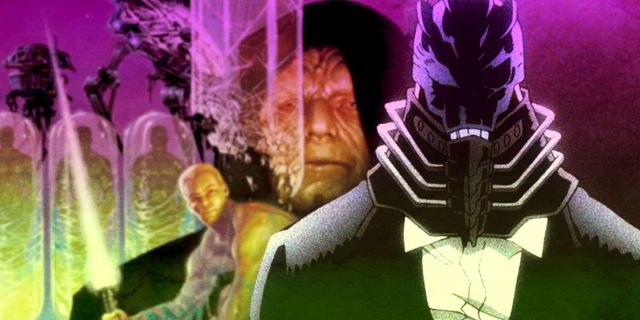My Hero Academia is a shonen anime that borrows many elements from not just shonen manga and American superhero comics but also the Star Wars saga, including both Legends and Disney canon material alike. Examples range from the Jaku hospital to Gran Torino being the next Yoda, and All For One is clearly a combination of Darth Vader and his master, Darth Sidious/Emperor Palpatine.
All For One has a scary black helmet like Darth Vader, but while Vader was merely an exploited fallen Jedi, Darth Sidious was a true mastermind who embodied the Dark Side more than Vader ever did, including unnatural acts such as cheating death. That’s what he did in the Dark Empire comics, and now All For One is doing it too through Tomura Shigaraki.
How All For One & Sidious Planned Ahead for Their Own Defeats

Fictional villains tend to be expert planners, using manipulation, deception, foresight and the control of vast resources to get their way and threaten the heroes. Darth Sidious is like that in all versions of Star Wars, aiming to cheat death and become the ultimate being. He got the idea from his master, Darth Plagueis, who inspired Sidious with his ability to create life via the Force and reach immortality. Sidious took it to the next level, creating clones of himself on the Deep Core world of Byss so he could survive in one of them in case of an emergency. The arrogant and powerful Sidious was confident that he and his Empire would never fall to the Rebel Alliance and the few surviving Jedi, but to his credit, Sidious took the possibility of his defeat and death seriously.
In the Dark Empire comics, Palpatine transferred his mind to one of those clones and rose again, younger and stronger than ever. Hero Luke Skywalker even had to “join” him to destroy this reborn Empire from within and take Sidious down a second time, and it was close. This storyline also inspired Sidious’ return in 2019’s The Rise of Skywalker, though it’s debatable whether that plot line lived up to its Dark Empire predecessor.
All this happened once again in recent My Hero Academia episodes, albeit with minor twists. Like Sidious, All For One is a cunning and selfish schemer who aims to reshape the world according to his will, using formidable and unnatural power to do so. After losing to All Might once again, All For One decided to become a more parasitic being and treat Tomura Shigaraki not just as his apprentice and successor but as his living vessel. All For One has possessed Shigaraki through his Quirk, and the two of them share one body. Shigaraki can even use AFO’s trademark Quirks, and as manga fans know, this combined being identifies more as All For One than as Tomura Shigaraki, allowing them to defeat Star and Stripe’s New Order Quirk.
AFO is smart enough to plan for his defeat, and he’s not arrogant or reckless enough to think he can win the battle against hero society alone. His powerful mind is his best weapon, not just his Quirk, and it paid off when he was reborn in Tomura Shigaraki to continue his evil in a new form. Tomura isn’t an actual clone and has his own mind, but for now, he is AFO’s Sidious-style contingency plan — a second body that may serve as the vessel of his revenge.
How Sidious & All For One Represent the Immortality of Evil

Some fictional villains, such as Darth Sidious and All For One, strive for immortality so they can rule the world for all time, but their immortality goes beyond their bodies. Such villains may still shape society even after they are defeated or killed because the true villainy is not just these people, but rather their ideas. Just as AFO and Sidious can hop into new bodies to cheat death and keep fighting, their visions for the future and their ideologies can be transferred to new vessels, even years or decades later. The idea of evil is intangible and indestructible, a phantom that no lightsaber or Quirk can ever destroy. So long as AFO’s and Sidious’ evil intentions survive, it doesn’t matter how many Sidious clones or villains are killed in battle.
This intellectual immortality is why evil and villainy persist in these fictional universes across lengthy timelines. Even if many villains and evil armies are destroyed, evil itself survives and will merely wait for a new person or group to embody it. Star Wars, for example, portrays many Dark Side villains across millennia, from Naga Sadow to Darth Bane to Darth Sidious, many generations apart. The Dark Side and the idea of evil parasitically jump from one body to another, always ready to fight on in a new form. All For One and Sidious may have made that literal with their new bodies to keep fighting the heroes in person, but protagonists like Luke Skywalker and Izuku Midoriya must understand that until the idea of evil is vanquished — if it ever can be — the death of one villain’s body means comparatively little.
